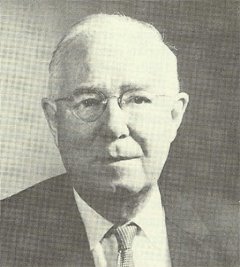Michigan's Musical Connection: Leo Sowerby
Welcome to the latest installment of my series, Michigan's Musical Connection. Every Saturday, I select an artist at random who has some connection to the great State of Michigan. The qualifications I have chosen for inclusion in this series is pretty broad. Artists that were either born in Michigan, raised in Michigan, or currently reside in Michigan. Pretty simple, right? With that said, let's get this entry underway.
Leo Sowerby was born in Grand Rapids, Michigan in 1895 and died in 1968. Mr. Sowerby was a composer and organist and studied at the American Conservatory in Chicago. He also studied in Rome in 1921 and later became a teacher at the American Conservatory. In 1927, he became the organist and choirmaster at St. James Episcopal Church in Chicago.
Here's a snip from an essay about Leo Sowerby -

Leo Sowerby began composing at the age of ten and through his career he totaled more than 500 works. Considered the pre-eminent American composer of organ music, Sowerby garnered recognition throughout his career which included a Pulitzer Prize for Music in 1946.
From Answers.com -
Leo Sowerby was born in Grand Rapids, Michigan in 1895 and died in 1968. Mr. Sowerby was a composer and organist and studied at the American Conservatory in Chicago. He also studied in Rome in 1921 and later became a teacher at the American Conservatory. In 1927, he became the organist and choirmaster at St. James Episcopal Church in Chicago.
Here's a snip from an essay about Leo Sowerby -

Sowerby was born on May 1, 1895 in Grand Rapids, Michigan, and spent most of his adult life in Chicago. He was thus one of the authentic musical voices of the Midwest, of the great American heartland. His talent blossomed early - his violin concerto was premiered in 1913, when the composer was 18 years old and his orchestral works were featured on programs by the Chicago Symphony Orchestra from his early 20s on. He went on to produce a catalogue of more than 550 works, including other concertos (for piano, organ, cello, and harp), five symphonies, and music in every other genre with the sole exception of opera. He was the first winner of the American Prix de Rome, he won the Pulitzer Prize in 1946 for his cantata The Canticle of the Sun, and his orchestral music was played not only by the Chicago Symphony, but by the Boston Symphony, the Philadelphia Orchestra, the New York Philharmonic, and many others. His success extended beyond the traditional classical concert stage. How many people who associate Sowerby only with organ and choral music know that when bandleader Paul Whiteman sought new works in the jazz idiom after his great success with Gershwin's Rhapsody in Blue, one of the first composers he turned to was Sowerby? (He wrote two works for Whiteman's band, one called Synconata and the other called Monotony, a piece for metronome and jazz band). His music could indeed vibrate with the syncopated urban accents of the Jazz Age, but he painted vivid musical landscapes, such as the tone poems Prairie and Comes Autumn Time (in both its orchestral and organ versions), or From the Northland, his evocation of the forests and Great Lakes of his native Michigan. His reputation as a specialist in sophisticated liturgical music was balanced by the fact that two of his best-sellers during his lifetime were his instrumental settings of The Irish Washerwoman and Pop Goes the Weasel.
With the sole exception of his pupil Ned Rorem, Sowerby was the last American composer with a national reputation in the world of concert music to display any more than a token interest in church music. He was organist of St .James' Episcopal Cathedral in Chicago for more than 40 years, and his liturgical music occupies a central place in his life's work and in the history of American church music. He produced a long list of anthems, each of which is a master class in the techniques of writing choral music. They illuminate the sacred texts in a truly symphonic style, and feature organ accompaniments that make integral and idiomatic contributions to the texture of the music - real organ music: no one-size-sort -of-fits-all "keyboard" parts like those which so many church music programs seem to demand today. (more...)
Leo Sowerby began composing at the age of ten and through his career he totaled more than 500 works. Considered the pre-eminent American composer of organ music, Sowerby garnered recognition throughout his career which included a Pulitzer Prize for Music in 1946.
From Answers.com -
Sowerby began piano lessons when he was seven and was teaching himself theory from a textbook at 11. He moved to Chicago in 1909 and continued his music studies while at Englewood High School. At age 15, Sowerby received some cursory instruction on the organ, but from then on would be self-taught.
Sowerby's debut as a composer came in 1913 when the Chicago Symphony at an all-America concert performed his Concerto for Violin and Orchestra. Four years later, Sowerby gave his first public performance on the piano at the Norfolk, Connecticut, Festival.
His first pair of published compositions was a Woodwind Quintet (1916) and Serenade for string quartet (1917), which was a birthday present to Elizabeth Sprague Coolidge. In December 1917, Sowerby went into the U.S. Army and served for 15 months in England and France as a clarinetist and bandmaster. Sowerby remained in Europe after his discharge from the army and began composing a series of works including his First Symphony, which led to him being awarded the first American Prix de Rome in 1921. For the next three years Sowerby resided at the American Academy in Rome, writing among others From the Northland a composition that would win the Society for the Publication of American Music Award. (more...)
Labels: Michigan's Musical Connection







0 Comments:
Post a Comment
Subscribe to Post Comments [Atom]
<< Home